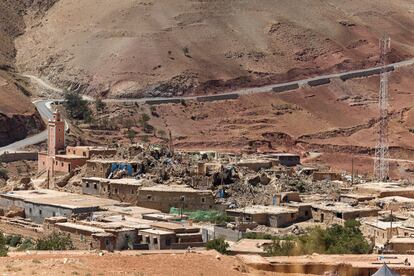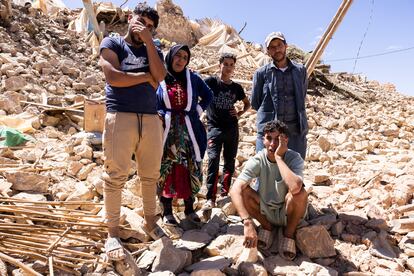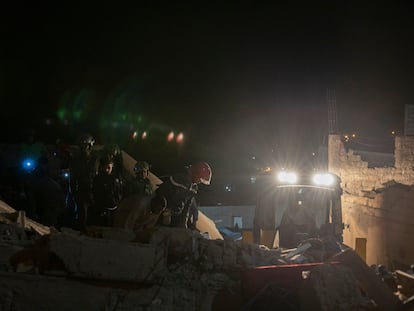The Moroccan villages that no one goes to, not even to dig up the victims of the earthquake
Seventeen of the 300 inhabitants of Tagadirt, a small town in the High Atlas, died under the rubble. The houses have collapsed and survivors have no food or drinking water. At more than 1,300 meters of altitude, they fear the arrival of winter

As you enter the P2009 road that connects Marrakesh with the village of Adassil (Chichaoua), you get the feeling that you are going nowhere. After 30 miles (50 kilometers) of travel, the police vehicles and ambulances dispatched to the area following the 6.8 magnitude earthquake that shook Morocco on Friday night, killing over 2,100 and injuring at least 2,400, begin to fade away. Cars and motorcycles become increasingly scarce. And it’s no wonder. This winding route crosses two mountain passes over 2,000 meters above sea level, places where it is necessary to slow down to avoid the huge rocks that dot the entire route and that no one has yet removed. From there, the road winds down into bare, desert land dotted with small valleys in which green patches of olive trees shine out. It is there, in those oases, where the people take refuge. That’s where Tagadirt is.
The last two bends in the road before reaching this village of 300 residents provide a view from above of the magnitude of the disaster. Only the mosque, whose minaret held up despite the crack that now splits it in half, and fewer than a dozen houses remain standing. The rest is a jumble of rocks and cement in which the residents desperately search for their belongings. A man with a hoe was trying to dig up the piece of plastic that his television has been reduced to, as if it were going to work again. The women placed salvaged pots, knives and teapots on nearby rocks. In the middle of it all, a woman who looked about 50 was crying next to one of her pieces of furniture. It is the only thing that Fadela Mhamd has left in this world. Her father-in-law and two sons died under the rocks that she is stepping on.
As the distance from Marrakech increases, assistance for the population decreases considerably. No rescue teams have been to Tagadirt yet. The 17 bodies have been dug up by the neighbors themselves. Unlike other locations closer to the city, no one has brought them water and food. The only assistance they have received so far is one crate of apple juice bottles and about 50 blankets to protect themselves from the cold at night. Some say that it was the Casablanca-based relatives of a local resident who sent the aid package. Others say it was an association. “What we need is water and food, and no one has given it to us so far,” says a man as he approaches a fig tree. “We only have this, which is a blessing from God,” he says, offering one of its fruits.

“I have lost everything, I have nothing left! Everything I had!” Mhamd sobs as she throws her arms over her head. Her son Mohamed, through tears, imitates the desperate gestures of his mother. “Everything we had is buried under here!” he exclaims, pointing to the rubble. “We have nothing left. We have nowhere to sleep and the night is cold. We have nowhere to go! We have nowhere to go!” he insists with the kind rage that is generated by pain. Their neighbors comfort them with prayers, kisses on the forehead and hugs. “This is a terrible disgrace. In a few weeks it will start to rain and then to snow. Where are we going to go?” says one of them. Tagadirt is located at more than 1,300 meters of altitude.
The few buildings that remain standing are full of rubble that makes them uninhabitable. The men, women and children who are still here do not sleep in them, but use them to store whatever belongings they have managed to recover. Their owners insist on showing them with a mixture of indignation and frustration, but also with a need to show their suffering. Telling someone about it seems to be somewhat therapeutic.
The mosque is standing, but next to it, the imam shows the destruction of his house while he removes what he can from it. A neighbor warns not to step on the power line that has fallen on the ruins, while another, laughing, grabs the cable: “But there is no electricity!” From a hole between the collapsed buildings come the braying of a donkey that has been trapped, and which a boy tries to help by offering some fodder.
A few miles further on, a Spanish medical rescue team from Seville has just arrived at the scene. At a bend in the road, they set up a tent next to the two mobile ICUs that they have managed to bring here from the Andalusian capital. Its members, who also helped out with the earthquake in Turkey and Syria last February, have come with two canine teams to search for survivors. Their first patient is a child with an epileptic seizure.
In the town of Taurir, the food bags arrive late in the afternoon. Each family in this town of about 500 inhabitants is waiting patiently to collect rations that have been sent by various non-profits. Meanwhile, the children run around and play soccer with an improvised paper ball. Once again, the inhabitants show the visitors the damage to their homes; they will sleep in improvised tents. But they are lucky, there are no deaths to report here.
Adasil, end of the route. In this town of 8,000 inhabitants, now practically deserted and with all businesses closed, the Gendarmerie and military vehicles reappear. The odd ambulance tries to make its way through the fallen rocks on the way to the next emergency. Observing the work of the rescuers, a question arises: how many more villages like Tagadirt will remain forgotten in Morocco?

Sign up for our weekly newsletter to get more English-language news coverage from EL PAÍS USA Edition
Tu suscripción se está usando en otro dispositivo
¿Quieres añadir otro usuario a tu suscripción?
Si continúas leyendo en este dispositivo, no se podrá leer en el otro.
FlechaTu suscripción se está usando en otro dispositivo y solo puedes acceder a EL PAÍS desde un dispositivo a la vez.
Si quieres compartir tu cuenta, cambia tu suscripción a la modalidad Premium, así podrás añadir otro usuario. Cada uno accederá con su propia cuenta de email, lo que os permitirá personalizar vuestra experiencia en EL PAÍS.
¿Tienes una suscripción de empresa? Accede aquí para contratar más cuentas.
En el caso de no saber quién está usando tu cuenta, te recomendamos cambiar tu contraseña aquí.
Si decides continuar compartiendo tu cuenta, este mensaje se mostrará en tu dispositivo y en el de la otra persona que está usando tu cuenta de forma indefinida, afectando a tu experiencia de lectura. Puedes consultar aquí los términos y condiciones de la suscripción digital.
More information
Archived In
Últimas noticias
Welcome to the post-religion era: The idea of Christianity as the absolute truth has become obsolete
‘I thought you would like it’: The risky sexual practice popularized by TV shows and TikTok
The digitalization of tourism: ‘They promise experiences and gave us the worst possible one’
Mexican peso defies uncertainty with forecasts of a new period of stability in 2026
Most viewed
- Sinaloa Cartel war is taking its toll on Los Chapitos
- Oona Chaplin: ‘I told James Cameron that I was living in a treehouse and starting a permaculture project with a friend’
- Reinhard Genzel, Nobel laureate in physics: ‘One-minute videos will never give you the truth’
- Why the price of coffee has skyrocketed: from Brazilian plantations to specialty coffee houses
- Silver prices are going crazy: This is what’s fueling the rally










































